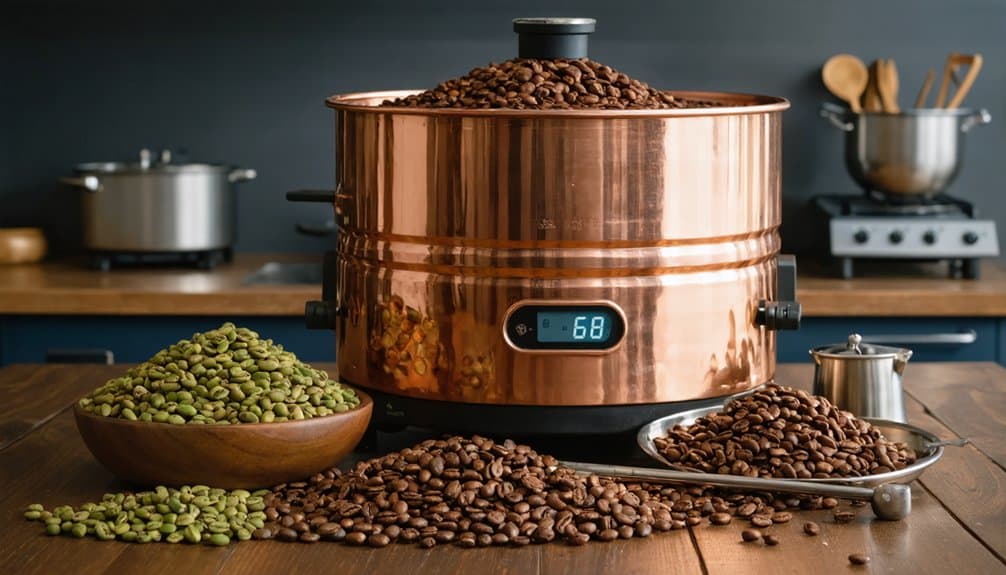You'll avoid costly mistakes in home coffee roasting by focusing on five critical areas: monitoring roast development time, maintaining precise temperature control, properly pre-heating equipment, preventing the dreaded baking effect, and managing consistent airflow. Pay special attention to initial crack timing, watch for scorching, establish reliable pre-heat routines, and maintain smooth temperature progression. Master these fundamentals and you'll reveal the secrets to achieving professional-quality roasts at home.
Key Takeaways
- Not preheating your roaster properly leads to uneven heat distribution and inconsistent roast profiles.
- Rushing through the development time after first crack results in underdeveloped, sour-tasting coffee.
- Ignoring bean density when setting temperatures can cause scorching in low-density beans or underdevelopment in high-density ones.
- Failing to maintain detailed roasting notes prevents you from replicating successful batches and learning from mistakes.
- Letting temperature spike dramatically during roasting creates the "baking effect," producing flat, straw-like flavors.
Mastering the Art of Perfect Roast Development

While many coffee enthusiasts dream of roasting their own beans, mastering roast development stands as the critical foundation for achieving exceptional results. You'll need to carefully monitor the time from initial crack to finish, as this development phase determines your coffee's final flavor profile. Shorter development preserves bright, acidic notes, while longer times improve body and caramelization.
To nail the perfect development, you'll want to calculate your roast development ratio, watch for visual cues, and listen for those distinctive crack sounds. Remember, each bean origin requires different parameters, so keep detailed notes as you practice and refine your technique. Beware that underdeveloped beans often produce unpleasant grassy and hay-like flavors that can ruin your cup.
Preventing Bean Scorching and Temperature Spikes
In the domain of preventing bean scorching, maintaining precise temperature control stands as your most critical challenge in home coffee roasting. You'll need to carefully match your preheat temperature to your batch size and bean density. High-density Kenyan beans can handle more heat, while Brazilian varieties need gentler treatment. Monitoring your drum speed rotation helps ensure even heat distribution across your beans. Watch your Rate of Rise like a hawk, ensuring it decreases steadily throughout the roast. Don't let your fan settings run too high at the start, and keep your chaff filter clean for ideal airflow. Remember, sudden temperature spikes are your enemy – aim for gradual, controlled heating that'll reward you with evenly developed beans.
Essential Equipment Pre-Heating Guidelines

Before charging your initial batch of beans, proper equipment preheating stands as a fundamental step toward achieving consistent, high-quality roasts. You'll guarantee even heat distribution and avoid common defects like scorching and tipping that can ruin your coffee's flavor profile. The thermal energy storage throughout your roaster promotes reliable batch outcomes.
- Start by warming your roaster without beans until it reaches target temperature
- Monitor temperature carefully, as electrical heat continues rising after switching off
- For Behmor roasters, aim for 250°F during pre-heat cycles
- Between batches, maintain consistency by following the same preheating routine
Understanding and Avoiding the Baking Effect
A skilled roaster's worst nightmare lurks in the seemingly innocent term "baked coffee" – a defect that robs your beans of their vibrant flavors and complexity. You'll know you've encountered it when your coffee loses its charm as it cools, leaving behind a hollow, straw-like taste that's far from the sweet, complex profile you're aiming for. The release of moisture during first crack often triggers this undesirable effect.
| Warning Signs | Prevention Steps |
|---|---|
| ROR crashes during roast | Maintain consistent heat |
| Flat, papery taste | Monitor temperature curve |
| Flavor loss when cooling | Proper equipment preheat |
| Straw-like notes | Avoid temperature stalls |
Don't let an ROR crash derail your roast. Focus on smooth temperature progression, especially before initial crack, when beans are most vulnerable to baking.
Managing Airflow and Rate of Rise for Optimal Results

Managing airflow and rate of rise effectively can make or break your coffee roast quality. You'll need to carefully monitor your roaster's airflow settings while considering ambient temperature changes that can affect your results daily. Your goal is to maintain stable airflow that prevents both over-roasting and under-roasting while ensuring proper chaff removal. Too little airflow can result in dry, baked flavors in your finished coffee.
- Pre-heat your roaster to establish consistent airflow before adding beans
- Monitor your rate of rise closely, adjusting fan speed as needed
- Keep your exhaust system properly configured with vertical connections up to 6 meters
- Maintain 60% airflow efficiency for peak pressure and control throughout your roast
FAQs
How Long Should Green Coffee Beans Be Stored Before Roasting?
You'll want to use your green coffee beans within 12 months of purchase for ideal flavor. If stored properly in airtight containers under controlled temperature and humidity, they'll maintain their quality.
Can Different Types of Beans Be Roasted Together in One Batch?
While you can roast different beans together, you'll get better results roasting them separately. Different beans have unique densities, moisture levels, and roasting characteristics that affect their ideal roasting times and temperatures.
What Safety Precautions Should Be Taken When Roasting Coffee at Home?
You'll need GFI-protected outlets, proper ventilation, and heat-resistant gloves. Don't leave your roaster unattended, watch for smoke, stop within 10 seconds of second crack, and keep a fire extinguisher nearby.
How Do Altitude and Humidity Affect Home Coffee Roasting?
You'll notice your roasting needs more heat at higher altitudes due to thinner air, while humidity requires longer roasting times as beans hold more moisture. Adjust your temperature and duration accordingly.
Is It Possible to Re-Roast Beans That Weren't Roasted Properly?
Yes, you can re-roast under-roasted beans, but you'll likely get inconsistent results. While it's technically possible, you'll sacrifice flavor quality and risk developing bitter notes in your coffee.
The Bottom Line
Persistently practicing proper roasting principles prevents problematic predicaments. You'll find that attention to temperature, timing, and technique transforms your home coffee roasting from mediocre to masterful. By monitoring your machine's mechanics, managing moisture levels, and maintaining meticulous measurements, you're well-equipped to dodge common disasters. Remember, roasting's refined rhythm requires regular repetition – so keep crafting those careful curves and controlling those essential variables.